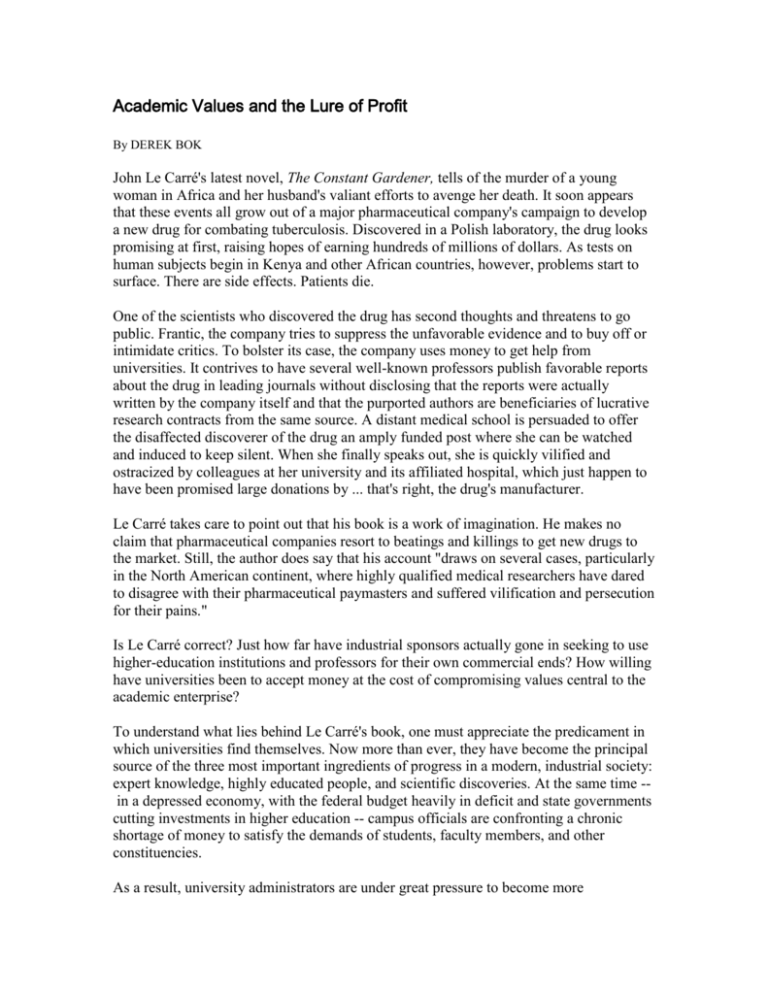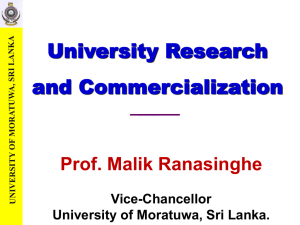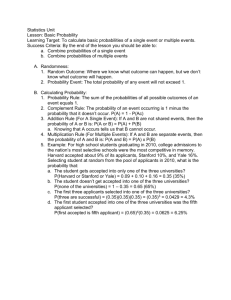Academic Values and the Lure of Profit
advertisement

Academic Values and the Lure of Profit By DEREK BOK John Le Carré's latest novel, The Constant Gardener, tells of the murder of a young woman in Africa and her husband's valiant efforts to avenge her death. It soon appears that these events all grow out of a major pharmaceutical company's campaign to develop a new drug for combating tuberculosis. Discovered in a Polish laboratory, the drug looks promising at first, raising hopes of earning hundreds of millions of dollars. As tests on human subjects begin in Kenya and other African countries, however, problems start to surface. There are side effects. Patients die. One of the scientists who discovered the drug has second thoughts and threatens to go public. Frantic, the company tries to suppress the unfavorable evidence and to buy off or intimidate critics. To bolster its case, the company uses money to get help from universities. It contrives to have several well-known professors publish favorable reports about the drug in leading journals without disclosing that the reports were actually written by the company itself and that the purported authors are beneficiaries of lucrative research contracts from the same source. A distant medical school is persuaded to offer the disaffected discoverer of the drug an amply funded post where she can be watched and induced to keep silent. When she finally speaks out, she is quickly vilified and ostracized by colleagues at her university and its affiliated hospital, which just happen to have been promised large donations by ... that's right, the drug's manufacturer. Le Carré takes care to point out that his book is a work of imagination. He makes no claim that pharmaceutical companies resort to beatings and killings to get new drugs to the market. Still, the author does say that his account "draws on several cases, particularly in the North American continent, where highly qualified medical researchers have dared to disagree with their pharmaceutical paymasters and suffered vilification and persecution for their pains." Is Le Carré correct? Just how far have industrial sponsors actually gone in seeking to use higher-education institutions and professors for their own commercial ends? How willing have universities been to accept money at the cost of compromising values central to the academic enterprise? To understand what lies behind Le Carré's book, one must appreciate the predicament in which universities find themselves. Now more than ever, they have become the principal source of the three most important ingredients of progress in a modern, industrial society: expert knowledge, highly educated people, and scientific discoveries. At the same time -in a depressed economy, with the federal budget heavily in deficit and state governments cutting investments in higher education -- campus officials are confronting a chronic shortage of money to satisfy the demands of students, faculty members, and other constituencies. As a result, university administrators are under great pressure to become more entrepreneurial. They feel compelled to search more aggressively for novel ways of making profits that can help meet pressing campus needs. Increasingly, one reads of new lucrative ventures launched by one university or another: medical-school consortia to test drugs for pharmaceutical companies; highly advertised executive courses to earn a tidy surplus for their business-school sponsors; alliances with venture capitalists to launch forprofit companies producing Internet courses for far-flung audiences. The "entrepreneurial university" is the subject of a growing body of scholarly literature and media commentary. Led by resourceful executives, these institutions are often portrayed in books and articles as constantly looking out for new and ingenious ways to serve society's needs while reaping profits with which to scale new pinnacles of excellence and prestige. Reading such accounts, skeptics are quick to assume that such institutions have turned their backs on their academic missions and to criticize them for attempting to bring such businesslike ways into the academy. Yet profit seeking has undoubtedly helped in some instances to improve academic work and to enhance higher education's value to society. Before Congress made it easy for universities to patent government-financed scientific discoveries and license them to corporations, administrators made little effort to scour campus laboratories for advances that could be turned to practical use to benefit consumers. Today, several hundred institutions have active technology-transfer offices to perform that function, and the number of patents issued to universities has grown more than tenfold. The lure of profit has likewise brought about keener competition to produce more and better-quality training programs for business executives than would have existed otherwise. Similar incentives could conceivably spur a more rapid development of Internet courses that will allow universities to make excellent educational programs available to distant audiences. But, in their pursuit of moneymaking ventures, universities also risk compromising their essential academic values. To earn a handsome profit from a company, business schools may divert assistant professors from their on-campus duties so that they can teach elementary material to entry-level executives. To win at football, colleges may admit students with grades and scores far below the normal requirements. To profit from the Internet, universities may offer gullible students overseas a chance to take inferior courses that will earn them a dubious certificate of business studies. Once such compromises are made, competitive pressures can cause the questionable practices to spread and eventually become so deeply rooted as to be well nigh irreversible. One can imagine a university of the future tenuring professors because they bring in large amounts of patent royalties, seeking commercial advertisers to sponsor courses on the Internet, and admitting undistinguished students on the quiet understanding that their parents will make substantial gifts. To avoid those pitfalls, universities need to examine the process of commercialization with greater care than in the past. Otherwise, they may gradually alter their essential character in ways that could eventually forfeit the respect of students and faculty members, and erode the trust of the public. History offers several lessons about commercialization that are well worth pondering. One conclusion that emerges repeatedly is that rewards from profit-seeking ventures seldom are as great as their university sponsors hoped at the beginning. High-profile athletics teams -- the academy's first big commercial venture -- have certainly produced revenues. But their costs have risen at least as rapidly, to the point where very few institutions consistently make money from their sports programs. Likewise, patent licensing has brought substantial revenues to a handful of universities, but most institutions do not earn much more than the cost of operating their technology-transfer offices. Internet courses have been recently touted as the latest El Dorado in the long history of commercial ventures. Not long ago, newspapers were filled with accounts of exciting new schemes offering large potential profits. In the last two years, however, New York and Temple Universities have both shut down for-profit Internet ventures, and Columbia University in January announced the demise of its widely publicized Fathom program after losing millions of dollars in the enterprise. If disappointing profits were the only problem with moneymaking activities, there would be little reason to lose much sleep over growing commercialization. But profit seeking has already shown disturbing tendencies to get out of hand and threaten far more important matters than expected revenues. In high-profile sports, for example, the prior grades and test scores of freshman athletes and their subsequent academic performance in college have fallen further and further below the levels of their classmates, and scandals have continued to erupt periodically in one university after another. While athletics may be dismissed as an extracurricular activity peripheral to the main academic enterprise, other commercial ventures have begun to strike closer to the core of research and education. In their zeal to build financial support from industry, many universities have signed research agreements with companies that allow more secrecy than is needed to protect the legitimate interests of their sponsors. Many campuses have failed to impose strict conflict-of-interest rules to prevent their scientists from performing experiments on human subjects for companies to which they have significant financial ties. Echoing the events described by John Le Carré, some universities have failed to protect their scientists from corporate pressure to suppress unfavorable research findings. Thomas Bodenheimer, a clinical professor of family and community medicine at the University of California at San Francisco, has even reported that as many as 10 percent of published reports by university researchers on the efficacy of products manufactured by the commercial sponsors of the research are actually ghostwritten by company personnel. As practices of this kind become more widely known, the public's confidence in the credibility and objectivity of university research is bound to suffer. Commercialization has also taken a toll on the quality of educational programs. Many institutions, seeking to profit from their continuing-education divisions, follow practices in those areas that they would never tolerate in their regular degree programs. They typically offer little or no financial aid, while paying salaries to instructors that are well below the normal university scale. As a result, access to such programs has suffered, along with the quality of teaching. In medical schools, administrators hoping to extract a greater surplus from continuingeducation programs accept substantial subsidies from pharmaceutical companies in exchange for agreeing to choose instructors from company-approved lists and allowing the sponsor to prepare the slides and teaching notes that are used in the lectures. Further harm could result from commercializing Internet programs if universities (and their venture-capital partners) try to maximize profits by attracting large audiences of unwary students with flashy lecture courses taught by famous professors who do not take full advantage of the (more expensive) interactive power that new technology allows to improve the effectiveness of teaching and learning. How significant are the questionable practices that many universities already tolerate? Because they involve values as well as money, the costs are impossible to quantify. But that does not mean they are unimportant. Far from it. It is vital to uphold admissions standards, preserve the integrity of evaluating faculty scholarship and student papers, maintain the openness and objectivity of scientific inquiry, and sustain other important academic values. These values are essential to maintaining the public's trust in student transcripts and published faculty research. They preserve professors' faith in the academic enterprise and help ensure that they will continue to regard their work as a calling rather than merely a way to make a living. University officials may insist that they can keep commercial activity from getting out of hand. Yet the long, sorry history of intercollegiate sports clearly shows how far the erosion of values can proceed. Through a series of small steps, many prominent institutions have come to sacrifice the most basic academic standards in their quest for added athletics revenue and visibility. Left unchecked, the chronic need for money could drive universities to similar extremes in more-central programs of education and research. What can universities do to protect themselves against that danger? Five steps seem especially important. First, universities should not rely upon presidents alone to protect the institution and its values from the pitfalls of commercialization. Presidents are under enormous pressure to find the money not only to balance the budget but to improve financial aid, build new buildings and laboratories, increase faculty salaries, launch new programs, and hire star professors to enhance the institution's reputation. Trustees judge presidential performance in substantial part by the amount of money that the chief executive raises. Faculty members hold presidents accountable for finding the means to fulfill intellectual ambitions. Students want better residence halls. Boosters insist on winning teams. In the face of these pressures, if presidents are left by themselves to preserve academic values, questionable compromises are likely to occur. Though none may be glaring by itself, their accumulation will gradually threaten the integrity of the institution. The values of a college or university can be preserved only if boards of trustees make upholding academic standards an integral part of evaluating presidents -- and insist on reviewing conflict-of-interest rules, admissions practices for athletes, and other standards that are at risk from commercialization. The second principle to observe is not to consider commercial opportunities on a case-bycase basis. Rather, institutions should insist on promulgating general rules to govern matters such as secrecy provisions in corporate-research agreements, admissions standards for athletes, and conflicts of interest for scientists. Ad hoc decisions are bound to lead to a gradual erosion of academic values; the cards are almost always stacked in favor of allowing moneymaking schemes to proceed. When such opportunities present themselves, interested faculty members and administrators are typically those with a stake in having the project move forward; the risks are usually too diffuse to generate opposition. The potential rewards seem tangible and very tempting at the outset, while the dangers will be speculative and hard to quantify. The hoped-for benefits are, for the most part, immediate, whereas the risks loom far in the future. In addition, the benefits accrue to the institution and its members, but the costs often involve matters, such as a loss of trust in the objectivity of research, that are shared by all universities. Similarly, the blame for turning a project down falls squarely on identifiable university officials, but the responsibility for undermining academic standards and squandering public trust can never be traced to any specific decision or institution. Under such circumstances, in the absence of clear, well-publicized rules, the path of least resistance will almost always lie in approving the questionable project. A third important principle is to involve the faculty in developing and enforcing all rules that protect academic values. Many administrators have a dangerous habit of regarding the faculty as an irritating obstruction to discussions of commercial ventures. The entrepreneurial university, it is said, must be able to move quickly. It cannot wait for windy faculty debates to run their course lest valuable opportunities be lost in the fastmoving corporate world in which we live. In fact, there is remarkably little evidence to support this view. Looking back over the checkered history of commercial activity on campuses, one can much more easily point to examples of costly unilateral decisions by impatient administrators, such as ill-advised Internet ventures or grandiose athletics projects, than to valuable opportunities lost through inordinate faculty delays. That is not to say that existing processes of faculty governance are perfect, or even nearly so. New and streamlined procedures may be needed, with smaller committees staffed by carefully chosen, well-respected, highly knowledgeable professors, in order to deal with conflicts of interest, secrecy, and other complex issues created by emerging commercial opportunities. Still, the essential fact remains that faculty members have the greatest stake in preserving academic values -- and hence have a critical role to play in making sure that the quest for revenue does not impair the basic intellectual standards of the institution. A fourth useful step in safeguarding academic standards is to look for opportunities for universities to agree among themselves on basic rules governing matters such as conflicts of interest in research, the length of time that results can be kept secret under commercially sponsored research agreements, or conference-wide rules protecting academic standards in athletics. The Ivy League agreement setting minimum admissions requirements for athletes is a case in point. Without such agreements, competition works to erode academic standards. In the struggle for revenue or competitive advantage, a few institutions are bound to succumb to the temptation to undertake highly questionable commercial ventures. Once a few agree, competitive pressures on other universities will cause them to do likewise. Before long, what began as suspect behavior will become accepted practice. Uniform rules, by agreement or by legislation, are often the only defense against such corrosive pressures (although universities need to take pains to avoid the sort of restrictive agreements without a redeeming public purpose that could run afoul of antitrust laws). Finally, reasonably stable government support is the ultimate guarantee of high academic standards. Faced with a choice between sacrificing academic values and enduring serious cuts in programs, most universities will find a way to choose the former. Fortunately, government support for higher education has been relatively generous over the years. That is one important reason why American universities have achieved such a place of eminence in the world. My point is not to complain or to urge massive increases in public support for higher education. I simply want to make clear that sudden, major cuts, or steady erosion of support over an extended period of time, will put intolerable pressure on universities to sacrifice important academic standards in the hope of gaining badly needed revenue through dubious commercial ventures. Above all, university leaders, faculty members, and trustees need to recognize the risks involved in pursuing more and more commercial ventures and begin to build sturdier safeguards. To be sure, setting proper limits and providing supportive structures will take a lot of work. Entrepreneurial professors may resist new rules. Boosters may protest athletics reforms. Corporations may balk at strict secrecy limits and refuse to enter into lucrative research contracts. Meanwhile, the temptation to push ahead will frequently be great. Most profit-seeking ventures start not with obvious violations of principle but with modest compromises that carry few immediate costs. The problems tend to appear so gradually that their link to commercialization may not even be perceived. Like adolescents experimenting with drugs, campus officials may believe that they can proceed without serious risk. Before succumbing to such temptations, university leaders should recall the history of intercollegiate athletics and ponder the sobering lessons that it teaches. Once the critical compromises have been made and tolerated long enough, universities will find it hard to rebuild the public's trust, regain the faculty's respect, and return to the happier conditions of earlier times. In exchange for ephemeral gains in the constant struggle for prestige, universities will have sacrificed essential values that are very difficult to restore. Derek Bok is a university professor and president emeritus of Harvard University. His latest book, Universities in the Marketplace: The Commercialization of Higher Education, will be published this month by Princeton University Press. http://chronicle.com Section: The Chronicle Review Volume 49, Issue 30, Page B7








